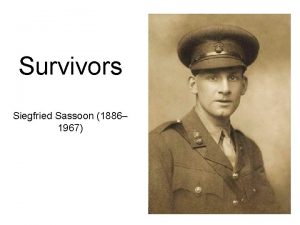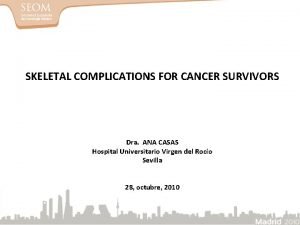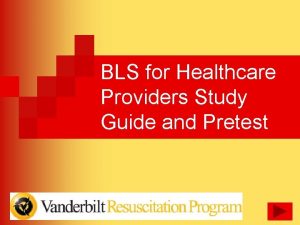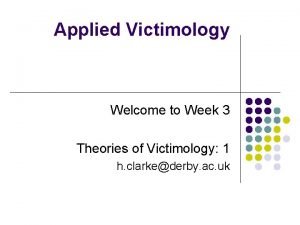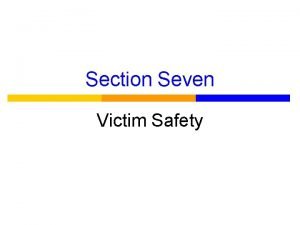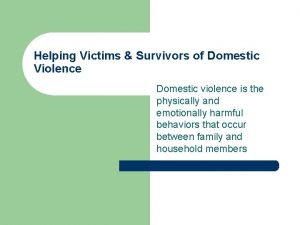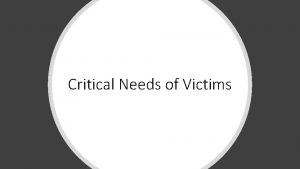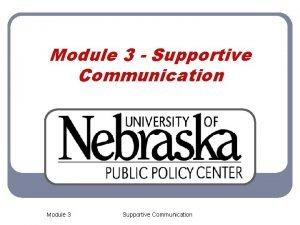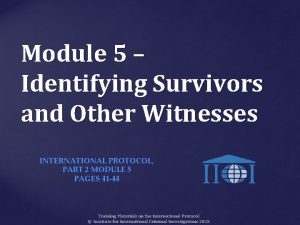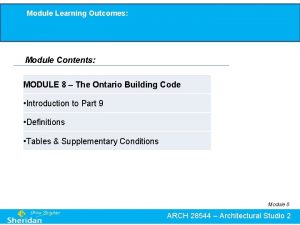Module 5 Communication with Victims and Survivors Learning

























- Slides: 25

Module 5 Communication with Victims and Survivors

Learning Objectives v Demonstrate your use of active listening techniques. v Differentiate between open-ended and closed-ended questions. v Demonstrate your use of five communication skills (e. g. , active listening, paraphrasing, reflective listening, affirmation, and open-ended and closed-ended questioning) to establish trust with a victim. 1

Key Communication Skills: Active Listening and Paraphrasing 2

Activity Listen to My Story 3

Introduction to Communication with Victim Survivors Foundation skills for effective communication: v Active listening v Paraphrasing v Reflective listening v Affirming v Open-ended and closed-ended questioning 4

Effective Communication In effective communication, one person conveys information or a message to another, and they both agree on the meaning. 5

Active Listening v Listening carefully to what the speaker is saying, without judgment or evaluation. v Listening to content of message as well as the feelings being expressed. v Attempting to stand in the other’s shoes to understand relate to another’s situation and feelings. 6

How Do You Practice Active Listening? v Be attentive. v Take time to listen to the story without interrupting. v Allow client to be silent. v Ask for clarification or repetition of statements. v Listen without judgment. v Set your reactions aside and focus on the victim’s feelings. 7

Activity It Changed My Life 8

Actions Speak Louder Than Words v Nonverbal communication v Face-to-face communication 9

Paraphrasing v Paraphrasing: Stating back to the victim in your own words what you understood the victim to say. v Purpose of paraphrasing: To make sure that you have heard and understood what the victim has said and is feeling. 10

How Do You Paraphrase? v Listen to the victim carefully, focusing on key words, phrases, and concepts. v Repeat what the speaker has said, using your own words, without changing the meaning. 11

Activity Paraphrasing 12

Key Communication Skills: Reflective Listening, Affirmation, and Open-ended and Closedended Questioning 13

Reflective Listening v Reflective listening: Reflecting their feelings back to victims. v Purpose of reflective listening: To make sure that you have understood what the victim is feeling, although the victim may not have expressed the feelings. 14

Techniques To Practice Reflective Listening v Listen to the victim carefully. v Make a mental note of key points. v Notice how you are feeling. v Ask yourself how you would feel if you were the victim as you listen to the victim share the experience. v Listen for what is not being said. 15

Activity It Changed My Life: Reflective Listening 16

Affirmation v Affirmation: Statements that recognize and validate a victim’s strengths. v Purpose of affirmation: To help build the victim’s confidence in his or her ability to persist. 17

Activity Affirmation 18

Open-ended Questions vs. Closed-ended Questions v Open-ended questions: Questions that cannot be answered by “yes” or “no. ” v Closed-ended questions: Questions that can be answered by either “yes” or “no. ” 19

Getting Information with Questions v Ask yourself what information you need to get before you ask a question. Ask questions that will help you provide effective services to the victim. v Ask questions one at a time. Multiple questions can easily confuse or put off the other person. 20

Activity Open- and Closed-Ended Questions 21

Using Key Communication Skills 22

Activity Communication Self -Assessment 23

Review of Module Learning Objectives v Demonstrate your use of active listening techniques. v Differentiate between open-ended and closed-ended questions. v Demonstrate your use of five communication skills (e. g. , active listening, paraphrasing, reflective listening, affirmation, and open-ended and closed-ended questioning) to establish trust with a victim. 24
 Siegfried sassoon survivors analysis
Siegfried sassoon survivors analysis Dra survivors
Dra survivors Native australian desert animals
Native australian desert animals Survivors teaching students
Survivors teaching students Calciphylaxis survivors
Calciphylaxis survivors Cuadro comparativo e-learning y b-learning
Cuadro comparativo e-learning y b-learning C device module module 1
C device module module 1 West memphis 3 victims autopsy
West memphis 3 victims autopsy Gerald gallego victims
Gerald gallego victims Joe tinning
Joe tinning Canadian centre for victims of torture
Canadian centre for victims of torture Word formation fashion
Word formation fashion Stephen schafer victimology
Stephen schafer victimology Year 11
Year 11 Hammock carry - three man carries
Hammock carry - three man carries Bls study guide
Bls study guide Religious beliefs about helping victims of war
Religious beliefs about helping victims of war Brandon crunkilton
Brandon crunkilton Richard chase case
Richard chase case Ideas have consequences bad ideas have victims
Ideas have consequences bad ideas have victims Hotel bridge collapse
Hotel bridge collapse 3 tiers of support for second victim
3 tiers of support for second victim Von hentig's psychological types of victims
Von hentig's psychological types of victims Victims definition
Victims definition Thourghout
Thourghout Characteristics of the victims of muti murders
Characteristics of the victims of muti murders
